We measure all sorts of metrics in our businesses.
From website visitors and the average number of support tickets you receive, to the revenue in your sales pipeline, you keep tabs on everything that influences your business performance.
Yet, we rarely consider how our average email response time affects our business, even though the data shows that fast email reply times lead to happier customers and more sales.
In this article, we’ll look at the average email response time, how it varies by industry, best practices to reduce your company’s average response time, and more.
Let’s jump in.
The average email response time is 12 hours.
We came to that figure by looking at the average response time across industries, including finance, real estate, logistics, retail, and corporate travel, and finding the average between them.
Companies around the world are leaving their customers, sales leads, and even team members waiting for almost two days before replying to them.
What’s even more surprising is how the average email response time is disconnected from customer expectations. A Salesforce study found that 77% of customers expect an immediate reply when they contact a brand, as illustrated by the image below:
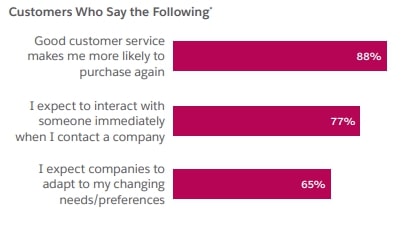
Image via Salesforce
The data shows how quick customer service resolution equals better customer experiences.
Also Read:
To surpass your competitors, you must first understand the average email response time in the context of your industry. We’ve compiled data on average email response times in the corporate travel, finance, logistics, real estate, and retail industries.
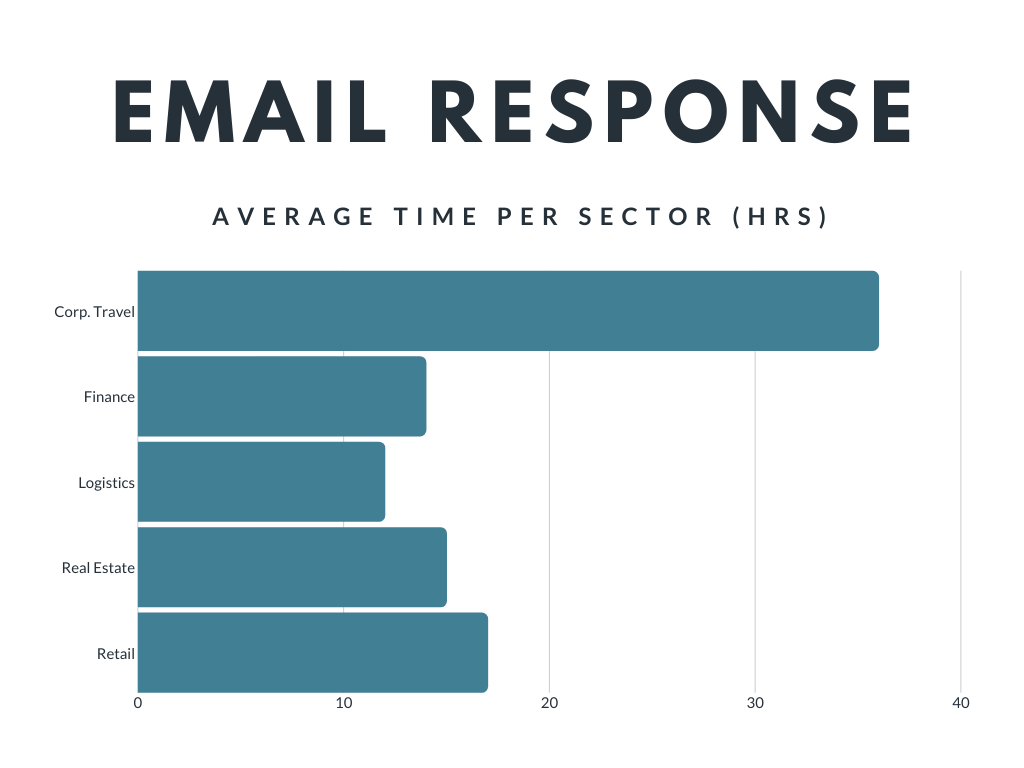
According to a study by EmailAnalytics Inc., 21% of customers said the average email response time should be under 4 hours.
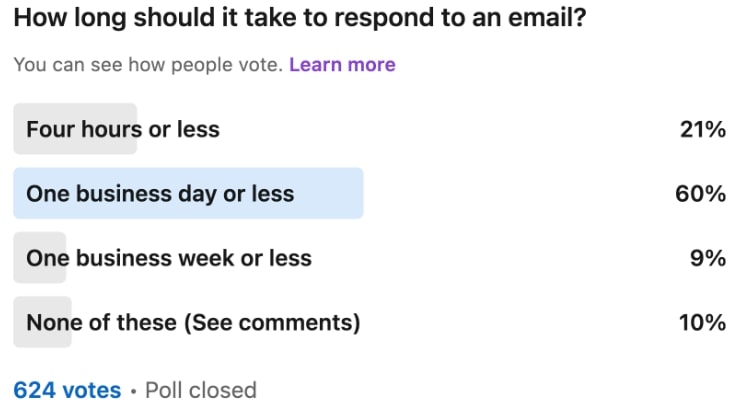
This statistic points to money being left on the table. Corporate travel contracts tend to be fairly large, recurring contracts for corporate travel businesses. The enquiries are time-sensitive, and a great average email response time plays a large role in providing the end solution to the customer.
Customers in this industry who are not serviced promptly will switch their corporate travel provider. You can use various customer support tools to reduce your customer response time because speed really matters in this industry.
Currently, the average email response time is the slowest of the industries we are comparing in this article due to the complexity of the requests.
Our research shows a better showing for the Finance sector, though not mind-blowing speeds at an average email response time of 14 hours. This is still a long time to wait for an email response and gives leads plenty of time to find other options in a heavily saturated market.
The Finance industry is enormously populated with ads, affiliates, promoted content, etc., so getting a lead is tough enough. Why wait to respond to them once you have them on the hook and risk them dropping off?
Optimizing your average email response time with timetoreply would guarantee that all your advertising spend doesn’t go to waste.
The logistics industry is the best-performing, coming in at an average email response time of 12 hours. This average response time might sound good (and relatively speaking, it is).
However, we need to be cognizant of the fact that nearly half of the people sending emails expect a response within 4 hours. This average email response time is three times worse than that. Still, congratulations to the Logistics sector for being the fastest on our list.
There’s clear potential for maximizing email impact in Logistics by closing this response gap and exceeding customer expectations.
Also Read:
With an average email response time of 15 hours, once again, at first glance, the Real Estate sector isn’t doing too badly. But delving deeper into some of the statistics gave us more insight.
According to Salesforce, 61% of organizations said they proactively addressed customer inquiries. However, only 33% of customers supported that claim.
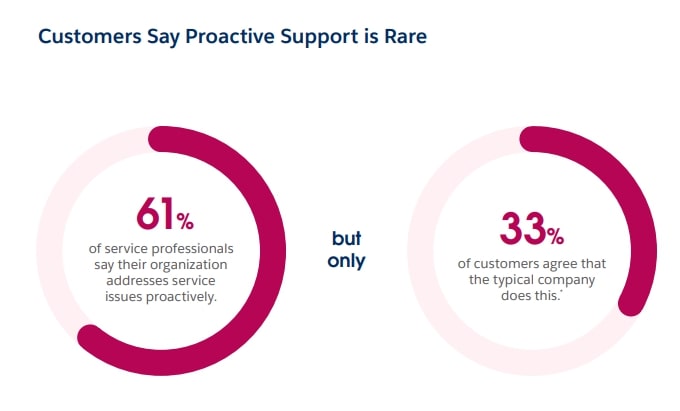
Image via Salesforce
This shows how easily trust can erode if customer expectations aren’t met. For real estate customer service teams, there’s still much room to improve their email response times.
This industry is massive, expected to grow to $8.6 trillion in the United States alone. If any industry has mastered responding to leads and customers quickly, it must be this one, right? Unfortunately not.
Our research found that the average email response time for retail businesses is a massive 17 hours.
There are, of course, some outliers here (as with every industry). Behemoths like Disney’s retail department, Abercrombie, and Office Depot have all managed to get their average email response time down below 2 hours.
According to the aforementioned Google research, this is likely to keep shoppers happy.
It also shows how lead response times affect sales and why they’re on top of their game. Imagine contacting two retail businesses; one responds in under 2 hours, the other a whole 15 hours after that – it’s not even a competition as to where you’ll end up spending your money.
Also Read:
How quickly and professionally you respond to emails can directly impact your brand reputation and operational efficiency. It can also help you improve customer satisfaction.
Here are some best practices you can follow to reduce your average email response time:
Your team is busy, and their work and general tasks every day will mean they can’t check their inbox around the clock. But if a key sales lead replies to your outreach email or a concerned customer reaches out with a question, you can’t leave them hanging.
The first actionable way to improve your email response times is to use an alert system.
The easiest way to set up real-time alerts for important emails is with timetoreply.
Once you’ve configured your alerts, your team will be notified whenever a priority email comes in. When they see the alert, they can jump into their inbox and start replying.
Your customers will appreciate your help, and your sales leads will see that your company is the most responsive out of the other vendors they’re talking to.
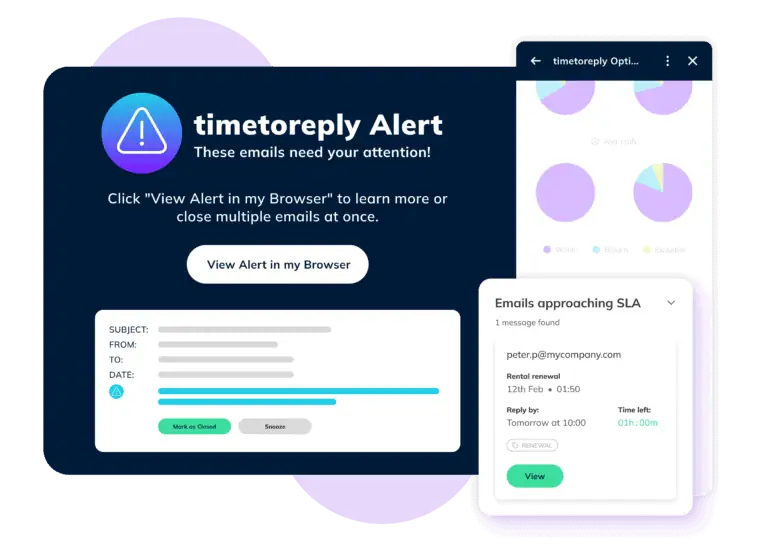
Your team already has a plethora of KPIs and targets to hit. If you’re not incentivizing them to improve their average email response time, it’s going to be hard for them to focus on as a goal.
The best course of action to take is to set reply time goals.
For example:
Once your internal goals are in place, your team is incentivized to hit them and make replying to customers and sales leads a priority.
It’s worth noting that you need to look at these email response goals in the context of their daily work. You can enhance productivity with email management software and improve average email response time.
If there’s a big project deadline coming up, the average response times may slip, but it may not necessarily be a bad thing if the project is going to deliver huge value for your customers.
Or, if your customer base is growing fast and your customer service team isn’t growing to handle it, there may be teething issues for a period of time where your team members adjust to the volume of inquiries they’re getting.
Every month (or over a time period that makes sense for your business), audit your average email response time metrics.
Go through them with individual team members, or in a team meeting, and assess how they stack up compared to your goals, team averages, and industry standards.
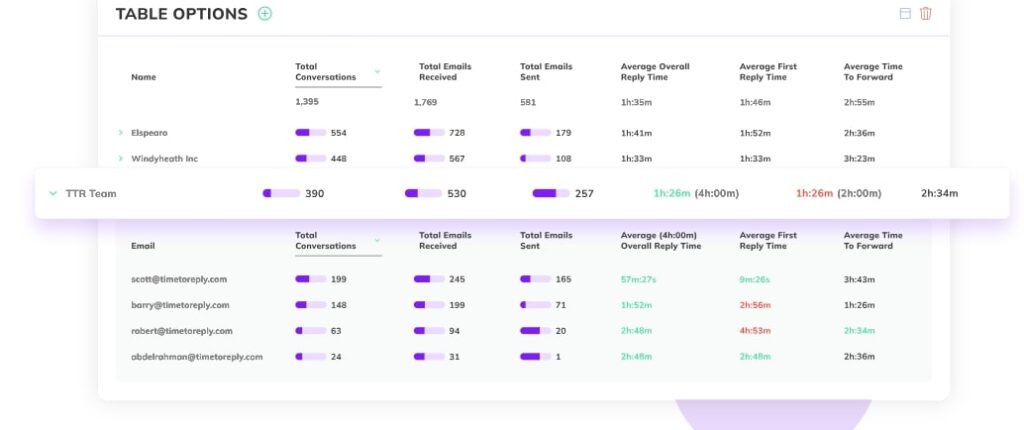
For example, you might notice that sales leads are being left too long, or customer service questions about a specific issue are being left waiting for longer than average.
In these cases, you can improve email communication skills and then work with your team to determine why the average email response time is slow.
Most situations with longer average email response times will be down to an issue with business processes, rather than individuals purposely ignoring their emails.
For example, it might be difficult to find up-to-date sales decks, or the documentation that your customer service team needs to solve a problem might be overly complex.
A simple but powerful way to reduce your email response times is to use a range of templates and standard operating procedures (SOPs) to help your sales and customer service team improve customer experience.
This is going to help you:
From there, you can build your templates and be confident knowing they’ll be used, rather than creating your templates before knowing which questions your team is hearing most often.
If you receive five emails at the same time, chances are, one of them is more urgent than the others. You need to treat your business emails in the same way.
To improve your average email response time, use a system that triages emails. You’ll be able to move high-priority emails to the top of the queue and leave lower-priority emails at the bottom.
Examples of essential emails that would be high-priority include:
Examples of follow-up emails that would be lower priority include:
While these follow-up emails aren’t necessarily low priority, they’re not as urgent as the previous examples.
The exact system you use to triage emails will depend on your company and internal goals, but it’s going to empower your customer service and sales team to make the right decisions about which emails receive replies first, improving the overall quality of your email conversations.
Finally, you’ll need a standard email response time policy.
Like the name suggests, it’s a set of rules and policies that outline expectations for email usage throughout your company and teams. Your average email response time policy will then be your source of truth.
You can use it to outline expectations for different departments, too. Customer support may need to respond to emails faster than your marketing team, and sales may need to be faster at replying than your operations team.
Regardless of the exact details, it’s vital to create this and get everyone on the same page.
As well as laying out general rules, you can add client-specific SLAs that your team needs to ensure are always met, and then track performance against those SLAs in timetoreply.
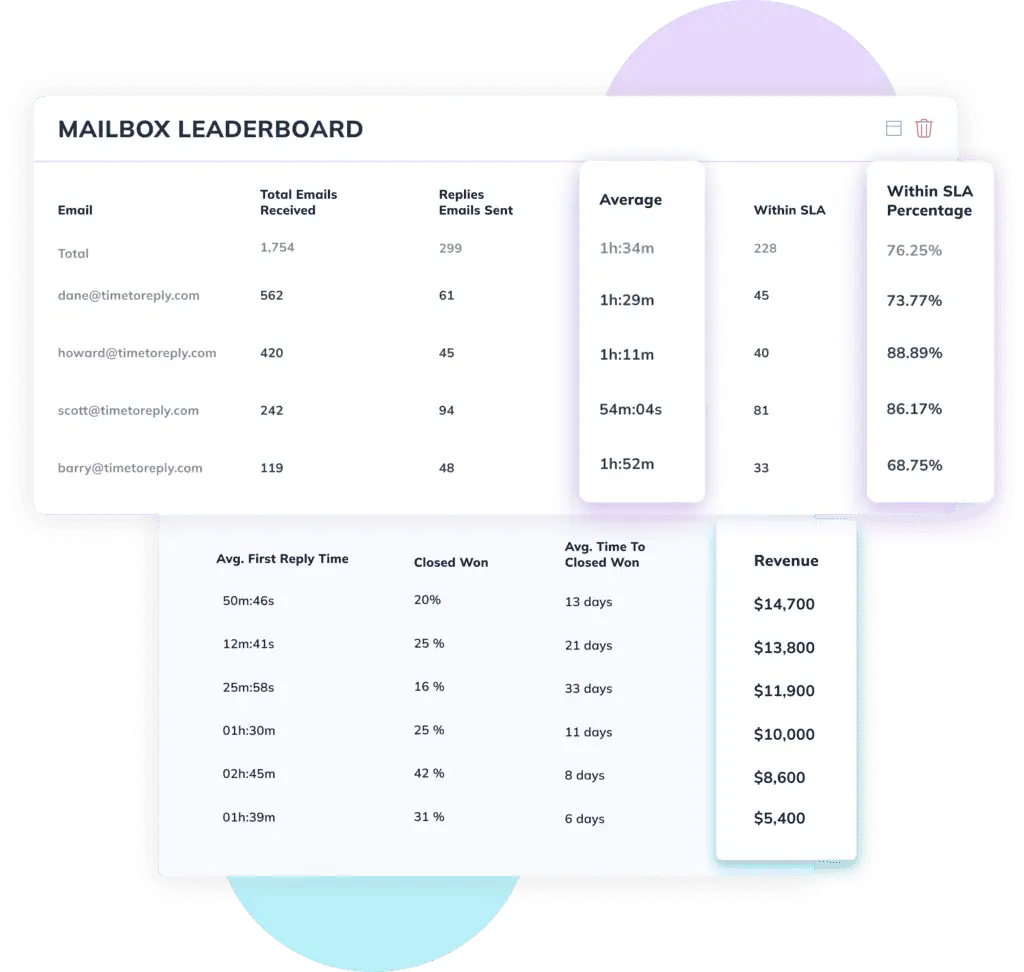
You can then use timetoreply’s reports to compare your team’s performance against your goals outlined in your standard email response time policy.
Over time, you can adjust your policy as your goals and priorities change, so make sure it’s not a document that your team looks at once and forgets.
Also Read:
Your average email response time shapes customer experience. This goes a long way in creating strong customer relationships and achieving business success.
Here are the key reasons why your average email response time matters:
No one likes to be left waiting for long after sending an email with a simple question or concern they’re having.
If you leave a customer waiting for too long, they’ll wonder if their email was sent correctly or if you’re ignoring them completely.
That’s why the first major benefit of improving your average email response times is achieving higher customer satisfaction levels.
One timetoreply customer, Swift Momentum, found that their average email response time increased by 300 to 400% once they started measuring and incentivizing faster reply times.
Their customers now get a better experience interacting with their business, and always know their questions will be resolved quickly.
When a sales lead reaches out to your business, it’s because they’re interested in solving a problem they have.
Chances are, they’re also researching other solutions and even reaching out to competitors.
If you can respond within the first few hours of the inquiry coming in, you’ll already be ahead of most companies.
However, you need to be above average to gain a serious competitive advantage.
71% of sales go to the very first company that responds, and that’s usually within the first 5-30 minutes.
If you can be that company, your sales pipeline will thank you.
Once you start measuring your average email response time, you can find ways to ensure your team reduces it, and you’ll always be the company that replies to a warm lead first.
If you’re consistently sending prompt replies to new leads, you’ll have more conversations with qualified leads and, ultimately, close more deals than the competition.
As well as looking at outward-facing emails, improving your average email response time will help your team in their day-to-day work.
For example, if a team member needs important information before a sales call or technical help to reply to a customer service email, they’ll be stuck if they can’t get a reply from other team members.
If you build a company culture where replying to team members and helping them to do their work effectively is encouraged, everyone will be able to perform at their best, and it will reflect in your business performance.
Your brand’s reputation is shaped by every interaction, for which your average email response time is essential. Prioritizing email responses shows you care about your customers and want them to feel valued and respected.
Also Read:
1. How long should it take to respond to an email?
Ideally, you should respond to emails within 12 hours to show that you’re committed to addressing customer concerns and queries promptly.
2. What is a good average email response time?
A good average email response time is under 12 hours. However, replying within 4 hours is ideal for customer service or business-related emails.
3. What is the 24-hour rule for email?
The 24-hour rule suggests replying to emails within a day to show reliability and professionalism.
4. How do I politely follow up on an email?
To follow up on your recipient’s email politely, wait 1 to 2 days. Then, kindly express continued interest while maintaining a courteous and professional tone.
5. What are the 4 Cs of email etiquette?
The 4 Cs include Clear, Concise, Courteous, and Correct. These ensure your message is understood, respectful, and free from errors.
Also Read:
Your average email response time is a key metric that you should be aiming to lower in your business.
The lower your email response times, the happier your customer base will be, and the higher your chances of speaking with qualified sales leads.
The average email response time is 12 hours, which is far longer than any customer or sales lead should have to wait, so your organization must work to beat the average.
If you need a platform to help you measure and manage your company’s email analytics, timetoreply is for you.
Once connected with your Gmail, Outlook, or custom inbox, it will start compiling your historical email activity, and showing you detailed reports with metrics including:
On top of that, you can use timetoreply to set goals, then compare your performance against those goals, and even set real-time alerts to notify your team when important emails come in.
Ready to start improving your email response times? Schedule a demo now.
Get live inbox alerts and reply quickly to customer emails with timetoreply